Common sheep diseases include footrot, scabby mouth, listeriosis, pneumonia, and Ovine Johne's disease. Farmers must know how to watch for signs of disease among their sheep, and take basic steps to maintain their health, including preventative measures like vaccination.
Table of Contents
Pneumonia and Pleurisy
Pneumonia in sheep is caused by a combination of viruses, larvae, and bacterias. This disease targets the lungs.
An infected sheep typically manifests clinical signs such as discharge from mucous membranes, weight loss due to appetite loss, and fever.
The susceptibility rate for pneumonia among younger sheep flocks is high, typically due to stressors such as improper ventilation, crowding, and dust.
In rare instances, pneumonia can also be due to improper drench procedures wherein fluid accidentally enters the lungs.
Ovine Johne’s Disease (OJD)
Ovine Johne’s Disease is caused by the bacteria Mycobacterium paratuberculosis. This particular disease is known as a chronic gastrointestinal infection.
Clinical signs include the thickening of the bowel lining, which then reduces the ability of the body to perform ingestion.
Infected sheep suffer from severe weight loss. Chronic scouring may be seen, and the sheep may drink and eat normally until they become too weak to continue.
There is no effective treatment for Ovine Johne’s Disease, but vaccination has proven to be effective. One sign to look out for is the presence of a slower group in a flock of sheep, made up of sheep that are in poor condition compared to the others in the flock.
Many affected animals do not show any signs of sickness for a long time. It can spread before showing any obvious clinical signs of being an infected animal.
Footrot
Infectious pododermatitis (also known as footrot or lameness in sheep) is a frequent occurrence, no matter what age the sheep is. The hoof is severely affected when footrot occurs. Two kinds of anaerobic bacteria cause it: Fusobacterium necrophorum and Bacteroides melaninogenicus.
When the foot is infected, the interdigital space becomes swollen and red, causing pain and necrosis, which then leads to lameness.
This bacterial infection can spread to the muscles of the legs and tendons, and the infected sheep can spread it to others in the herd very quickly. Sheep houses have to be kept hygienic and their feces cleared as soon as possible.
People sometimes mistake this for blackleg because of similarities in clinical presentations.
Scabby Mouth
Contagious ecythma, otherwise known as orf or scabby mouth, is an extremely contagious viral disease that occurs not only in sheep, but in goats and sometimes in humans, too. The virus that causes scabby mouth enters the body of the sheep through skin abrasions that are usually found on the legs, mouth, feet, poll, and teats.
Sheep that are most likely to get infected by this are those who graze on harsh feed or stubble because they usually get small abrasions on their feet and mouth.
Scabs can form on the teats and udder of ewes, or they may also develop mastitis even when they’re just producing colostrum.
Ewes that are affected may not allow their lambs to suckle, which could lead to decreased weight gain or even lamb losses. Mastitis may affect a portion of the ewes. This affects the sheep industry as live sheep exports can be affected because the animals are closely confined.
Sheep can receive a vaccination against scabby mouth.
Listeriosis
The onset of listerioris is rapid, and affected sheep may die within 24 to 48 hours after the onset of the signs.
Listeriosis is caused by the bacteria Listeria monocytogenes. The gastrointenstinal tracts of mammals and the soil are the natural reservoirs for the bacteria, which is why sheep usually ingest them through direct contact to contaminated fecal matter while grazing in pastures.
It is also possible for the bacteria to enter the body through inhalation or open wounds (lesions). When the sheep also consume corn silage or haylage that is moldy, there is a higher chance of getting listeriosis and toxoplasmosis.
This disease can cause septicemia, meningoencephalitis, or abortion among infected sheep. The clinical signs include facial paralysis, depression, anorexia, excessive salivation, disorientation, and when it is severe, affected animals may show involuntary running motions while they are on their sides.
What viral diseases affect sheep?

Many viruses affect sheep either short-term or leading to a terminal disease. The following are known viral diseases in sheep:
- Akabane virus infection
- Bluetongue disease
- Border disease (hairy shaker disease)
- Cache Valley virus infection
- Caprine arthritis encephalitis (CAE)
- Enzootic nasal adenocarcinoma
- Dermatitis
- Foot-and-mouth disease
- Q fever
- Mastitis and lesions, especially seen in weaning sheep (in gestation stage)
- Nairobi sheep disease orthonairovirus (NSDV) infection
- Orf or scabby mouth
- Ovine encephalomyelitis (louping ill)
- Ovine progressive pneumonia (OPP)
- Ovine pulmonary adenocarcinoma
- Ovine rinderpest, also known as peste des petits ruminants (PPR)
- Rift Valley fever
- Schmallenberg virus infection
- Ulcerative dermatosis
- Coccidiosis
- Variola caprina (goatpox)
- Variola ovina (sheeppox)
- Toxoplasmosis caused by toxoplasma gondii
- Wesselsbron virus infection
- Infection of the mucous membranes
What is the most common cause of death in sheep?
According to US Department of Agriculture, the largest non-predatory related deaths among sheep are those caused by changes in weather.
Changes in weather can lead to sheep freezing, contracting pneumonia, or being more likely to pick up a disease like footrot.
When significant infections are spreading, culling may be recommended to prevent further spread.
What diseases can sheep be vaccinated against?
Most bacterial and viral diseases can be prevented through sheep vaccination. Among the infectious diseases that are curbed by vaccines are:
- Clostridial diseases
- Footrot
- Caseous lymphadenitis (inflammation of the lymph nodes)
- Campylobacter fetus
- Bacterial pneumonia
- Ovine enzootic abortion
- Brucellosis
- Tetanus
- Campylobacteriosis
- Haemonchus

